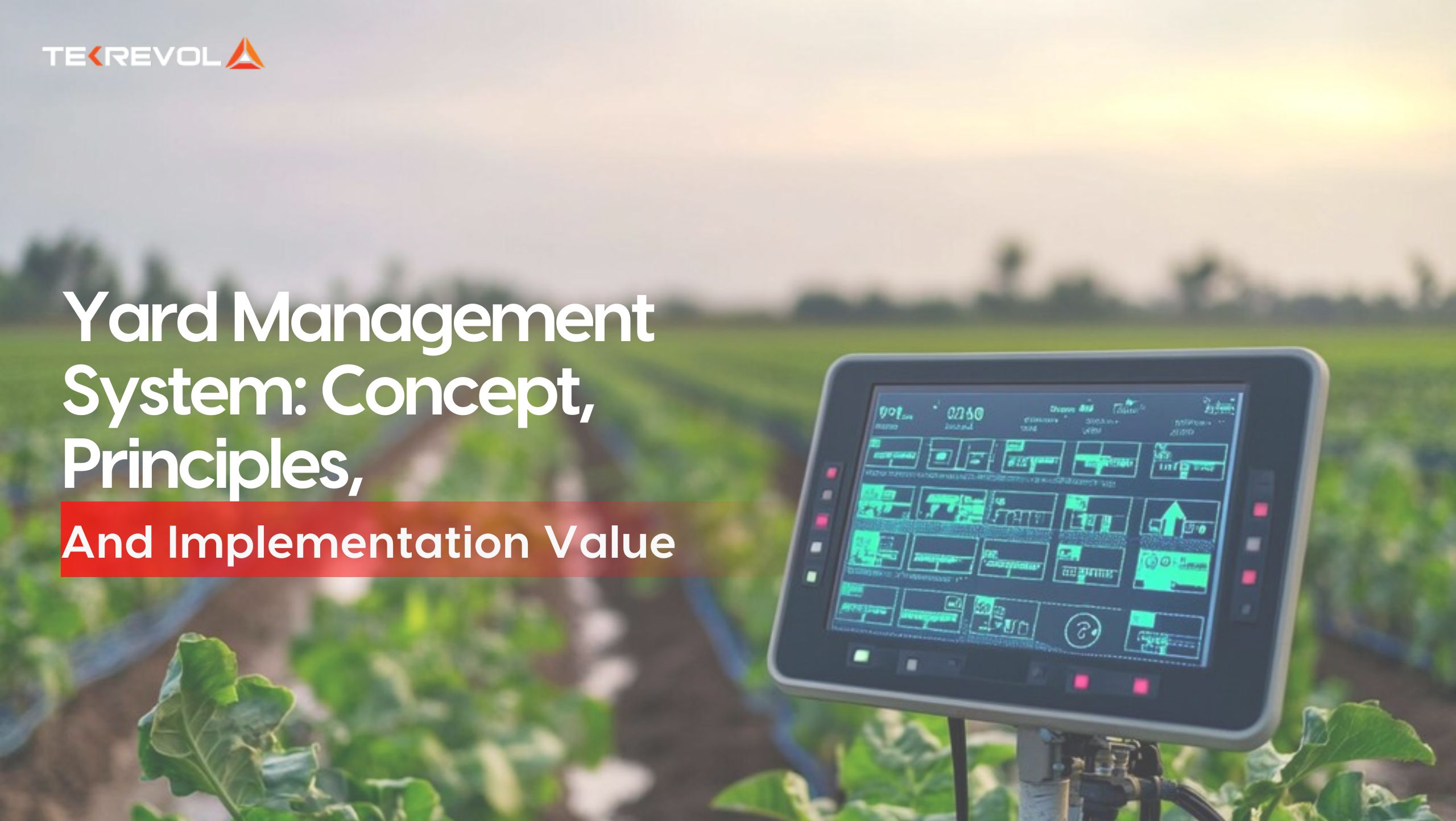Managing a supply chain logistics business is like dealing with the stock market – where every second counts!
Problems like Misplaced trailers, delayed shipments and inefficient yard operations can cause severe bottlenecks that can hinder the entire yard management process – and this is the last thing you want, right?
This is where we introduce you to the Yard Management System (YMS) – the ultimate solution to all your logistics-related problems. Is it really worth it? Well, the global YMS market was valued at $3.2 billion in 2024, with projections to hit $6.5 billion by 2028. – which clearly portrays the promising future it holds.
Saying that, if you are battling with delayed shipments or drowning in paperwork, you are in the right place. Here’s an exclusive guide that dives deep into the concepts, principles, and value of implementing a YMS.
Understand the Yard Management Systems
Yard Management System is the unsung hero, ensuring that your shipments won’t play hide and seek on you. This is a highly sophisticated solution aimed at controlling trailer and container movements within your facility, helping businesses simplify operations and reduce downtime.
Let’s understand the fundamentals by reviewing the key components of the Yard Management System.
Key Components of Yard Management System
- Software Infrastructure: This can be considered the brain of your yard management platform that coordinates tasks to ensure seamless business operations.
- Hardware Integration: This includes RFID tags, GPS, and sensors – the eyes and ears of your yard asset management, providing real-time data about trailer locations and statuses.
- Real-Time Data Analytics: Who does not love a good chart? Analytics give a glimpse into the operations, where inefficiencies may be spotted even faster than it takes to utter “logistics yard management.”
Difference between YMS, WMS, and TMS
For a better understanding, here are the differences between some of the popular terms you’ll come across in yard management systems.
- Warehouse Management System (WMS): It is responsible for managing the inventory within the warehouse.
- Transportation Management System (TMS): It’s responsible for the planning and executing the transportation of goods.
- Yard Management System (YMS): Bridges the gap between WMS and TMS, managing the flow of goods in the yard.
Why You Should Go With A Yard Management System?
Implementing yard management solutions can lead to significant improvements for your business. Some of them are mentioned below:
- Operational Efficiency: According to ABI Research, it’s believed that Global YMS revenue will exceed $3 billion by 2030, proving this technology is widely being adopted across industries.
- Cost Reduction: A business research company stated that the estimated market size of the dock and yard management system market will grow from $3.65 billion in 2023 to $6.5 billion in 2028, driven by the constant need for cost-effective logistics solutions.
- Real-Time Decision Making: Real-time data helps businesses make informed decisions, making operations much more successful and versatile.
- Enhanced Collaboration: Integration with carriers and suppliers ensures everyone is on the same page, singing the same logistics hymn.
Fundamental principles of Yard management
As easy as it may sound, Yard Management solutions come with complexities that can make any newbie go crazy. Just like a game of the puzzle, you need to get all the elements of Yard management right to ensure t seamless presentation.
Now, let’s move down to the more fundamental principles to know what makes yard management effective.
-
Visibility and Transparencies
Searching for a trailer in a yard is similar to searching for a needle in a haystack. A strong yard management system gives you real-time visibility into yard operations, helping you know the exact location of every asset – along with its status.
All this transparency reduces search times and increases decision-making power.
-
Smooth operations and reduced dwelling time
Time is money, and that is very evident in logistics. The efficient yard management solutions have streamlined the workflows. This eliminates any delays or extended dwell times, thus helping save costs while maximizing productivity.
-
Enhancing Resource Use and Optimization
Your ultimate goal would be to make your yard operations as efficient as possible, right? Well, it can’t be achieved when all of your operations are done manually.
A yard management system ensures that all of your yard resources are utilized efficiently and optimized to work seamlessly, even in extreme workloads.
-
Safety and Compliance
Your safety always comes first! A proper container yard management system enforces safety protocols and compliance with industry regulations, reducing accidents and legal complications.
-
Automation through Technology
In the age of technology, if there’s one thing that tends to be the real game-changer, then it’s none other than “Automation.”
Yard management system software and mobile apps can automate manual processes, contributing to reducing human error and producing optimum results.
-
Effective Communication
Communication is the key, especially when you need to coordinate with your team over complex logistics operations.
A centralized yard management platform can enhance communication between departments, suppliers, and carriers to ensure that everyone is on the same page.
-
Continuous Monitoring and Improvement
Regular monitoring and analysis of the yard operations enable continuous improvement, thus able to identifying bottlenecks and finding effective solutions in a timely manner.
Benefits Of Getting A Yard Management Systems (YMS)
Implementing a Yard Management System (YMS) is similar to upgrading from a flip phone to a smartphone in the logistics world.
Let’s explore the tangible benefits that a YMS brings to the table, all while keeping things light and professional.
-
Enhanced Operational Efficiency
A YMS streamlines yard operations by providing real-time visibility of the location and status of trailers and containers. This transparency reduces idle time and accelerates decision-making processes.
-
Cost Reduction
A YMS optimizes yard space utilization and improves dock scheduling to minimize delays and reduce operational costs. The business research company forecasts the dock and yard management system market to grow from $3.65 billion in 2023 to $4.09 billion in 2025, indicating a room full of possibilities.
-
Improved Resource Utilization
Ideal yard management solutions would not only ensure the best distribution of available resources but also maximize efficiency. This further results in better planning, which reduces the interferences of manual interventions, hence minimum chances of making errors.
-
Improved Safety and Compliance
An exclusive container yard management system comes in handy with safety protocols and industry regulations that help avoid accidents and legal complications. This is essential in ensuring a safe working environment as well as getting “workplace fines.”
-
Scalability and Flexibility
Modern yard management system software is super scalable, allowing businesses to change demands without overhauling existing systems. This allows flexibility to accommodate growth and seasonal fluctuation in logistics yard management services.
-
Mobility Integration with Apps
The Yard management apps offer the ability to monitor and manage activities within the yards in real-time. This opens the room for getting mobile responses and sound decision-making skills, ensuring smooth operations, even in the absence of on-site managers.
-
Competitive Advantage
Automating the advanced yard management services yields competitive advantages such as the shortening of turnaround times and an improvement in customer satisfaction. Saying that, the more happy your customers are, the more appreciation and profit you’ll be getting.
- Get Your Yard Operations Streamlined With Just One Click!
- Let Our Experts Automate Your Yard And Transform It Into Something Incredible!
Challenges and solutions in yard management
Without a doubt, a well-managed yard operation forms the basis of a strong supply chain – but you should know that nothing in life comes easy.
From a messy yard’s asset management to maintaining a smooth workflow – managing everything can be a nightmare, especially when you’re just a beginner at this.
Fortunately, with a well-implemented yard management system (YMS), you can easily overcome the challenges.
Here’s a comprehensive section that focuses on the challenges of yard management, and also brings you the handy solutions that you can use to tackle them.
Key Challenges in Yard Management
Let’s have a look at the challenges first!
-
Lack of Real-Time Visibility
One of the biggest issues in logistics yard management is the inability to track assets, trailers, and containers inreal-timee. Without visibility, yards are black holes that lose time and resources, thus increasing inefficiency and costs.
-
Manual Processes and Paperwork
Despite all the technological advancements, most organizations still use manual processes. This reliance often leads to misplaced documents, errors, and time-consuming workflows, which affects operational efficiency.
-
High Operational Costs
Detention fees, unnecessary labor costs, and underutilized resources are some of the results of inefficient yard processes, which ultimately have a direct impact on high operational costs.
-
Integration Issues with Existing Systems
The systems in modern logistics include Warehouse Management Systems and Transportation Management Systems. Saying that adding a new YMS to existing systems is often a challenge.
-
Safety and Compliance Issues
A disorganized yard that doesn’t comply with rules and regulations increases the likelihood of accidents, which may attract legal and financial consequences.
-
Resource Allocation Challenges
The absence of real-time data for allocating personnel, equipment, and vehicles results in resource wastage and lower productivity.
-
Delayed Shipments
The inefficiency of dock scheduling and asset management leads to shipment delays, which might affect the whole yard management supply chain.
How Does a YMS Solve These Challenges?
Here are the solutions to all of the challenges you read above:
-
Real-Time Visibility with Yard Management Platforms
The yard management system software tracks asset location and status by utilizing GPS tracking, RFID tags, and sensors. Having real-time visibility of your yard eliminates the guesswork, allowing managers to optimize their operations and avoid delay.
-
Automation of Manual Processes
Yard management automation allows tasks such as gate check-ins, scheduling, and reporting to be automated, removing the paper and associated errors and leaving more time to be focused on high-value activities.
-
Cost Reduction Through Optimization
A YMS minimizes dwell times, detention fees, and labor costs by optimizing trailer movements and resource allocation.
-
Seamless System Integration
Modern YMS platforms integrate with WMS and TMS for smooth data flow and unified operations.
-
Improved Safety and Compliance
A YMS drives safety protocols by observing yard operations while enforcing compliance standards. This minimizes accident incidents and possible legal liabilities.
-
Optimized Resource Allocation
Real-time data leads to the effective deployment of personnel and equipment in the best possible way. It maximizes yard asset management and productivity in general.
-
Improved Shipment Scheduling
The dynamic scheduling tools include all YMS solutions regarding dock assignment and trailer movements, which ensure that shipments go out in a timely manner and customers are delighted.
Too Much Information To Cope Up? Here’s a summarized table for you!
| Challenge | Solution |
| Lack of Real-Time Visibility | Use yard management platforms with GPS tracking and RFID for precise asset monitoring. |
| Manual Processes and Paperwork | Automate workflows using yard management automation to eliminate errors and inefficiencies. |
| High Operational Costs | Optimize trailer movements and resource usage with yard management system software. |
| Integration Issues | Implement a YMS designed to integrate with WMS and TMS seamlessly. |
| Safety and Compliance Concerns | Monitor operations and enforce safety protocols through a container yard management system. |
| Resource Allocation Challenges | Utilize real-time data to allocate personnel and equipment efficiently. |
| Delayed Shipments | Implement dynamic scheduling tools in YMS to streamline shipment coordination. |
Steps Towards Implementing a Yard Management System (YMS)
Implementing a Yard Management System (YMS) is like conducting an orchestra – each piece must come together to create something beautiful, efficient, and productive. Let’s walk through the necessary steps so that your YMS implementation hits all the right notes.
-
Evaluate Your Current Yard Operations
Look at your existing yard operations before jumping into the YMS pool. Identify bottlenecks, inefficiencies, and areas screaming for improvement. This self-reflection sets the stage for a tailored solution that addresses your unique challenges.
- Workflow Analysis: Map out current processes to pinpoint inefficiencies.
- Gather Stakeholder Input: Engage with staff to understand pain points and suggestions.
-
Define Clear Objectives and Goals
Set SMART goals for your YMS implementation. Whether that’s a reduction in truck turnaround time or better real-time visibility, clear objectives will help guide your project toward success.
- Determine Key Performance Indicators: Determining dwell time reduction and other asset utilization metrics will aid in measuring progress.
- Align with Business Strategy: YMS goals should align well with company-wide goals.
-
Determine Your YMS Solution
Select the right yard management system software. Think about scalability, integration capabilities, user-friendliness, and vendor support. Remember, one size doesn’t fit all.
- Compare Multiple Vendors: Features, pricing, and customer reviews.
- Request Demos: Take the software for a test drive to see if it will fit your operations.
-
Plan for Integration with Existing Systems
Your new YMS should play well with others, especially with your Warehouse Management System and Transportation Management System. Seamless integration ensures that your data flows smoothly across platforms, providing you with greater overall efficiency.
- Evaluate Integration Capability: Make sure that the YMS supports APIs or other integration methods.
- Liaise with IT Department: Plan for technical requirements and potential challenges
-
Develop a comprehensive implementation plan.
A good plan is a roadmap for the successful implementation of anything! Timelines, roles, and lines of communication must be determined so the whole team is on the same page.
- Project Timeline: List down important milestones and deadlines
- Assign Roles and Responsibilities: Provide the team members for specific tasks
-
Train Your Team
Even the most advanced YMS is only as good as its users. Invest in comprehensive training to ensure your team can leverage the system’s full potential.
- Conduct Training Sessions: Offer hands-on training for all users.
- Provide Ongoing Support: Establish resources for continuous learning and troubleshooting.
-
Monitor, Evaluate, and Optimize
Implementation doesn’t end with your yard management software going live. Even after the launch, you need to continuously monitor performance, gather feedback, and make necessary adjustments to optimize the system’s effectiveness.
- Track Performance Metrics: Regularly review KPIs to assess success.
- Solicit User Feedback: Encourage input from staff to identify areas for improvement.
Here’s A Check List To Ensure You’ve Got Everything At Your Fingertips!
| Step | Description |
| Assess Current Operations | Analyze existing workflows to identify inefficiencies. |
| Define Objectives and Goals | Set SMART goals aligned with business objectives. |
| Select the Right YMS Solution | Choose software that fits your operational needs and integrates well with existing systems. |
| Plan for Integration | Ensure compatibility with current WMS and TMS for seamless data flow. |
| Develop Implementation Plan | Create a detailed roadmap with timelines and assigned responsibilities. |
| Train Your Team | Provide comprehensive training to maximize system utilization. |
| Monitor, Evaluate, and Optimize | Continuously assess performance and make adjustments for improvement. |
Implementing a YMS is a strategic move that can significantly enhance your logistics yard management. These steps set the stage for a successful implementation that streamlines operations, reduces costs, and boosts overall efficiency.
Remember, the journey doesn’t end with implementation; continuous evaluation and optimization are key to reaping long-term yard management system benefits.
- Ready To Transform Your Yard Into Something Extra-Ordinary?
- We’ve Some Tricks That Can Help WIth Your Transformation
How Can TekRevol Help with Your Yard Management System?
When it comes to getting a profound yard management system, you need someone who has a sound knowledge of logistics and can deliver you a wise solution for all of your problems – and this is where TekRevol steps in!
From intuitive design for yard management apps to cutting-edge yard management automation technology integration, we design systems that put chaos to rest.
Whether you are struggling with real-time tracking or need a mobile app development company that gets logistics, we have your back.
Here’s the kicker: our team specializes in transforming even the most chaotic yards into well-oiled machines. With TekRevol, you’re not just implementing software- you’re investing in a solution that delivers tangible yard management system benefits and scales with your operations.
Let’s simplify, streamline, and revolutionize your logistics yard management together!
- Ready To Take Your Yard Management To A Whole New Level?
- Let’s make your yard smarter, faster, and better.

 40 Views
40 Views April 24, 2025
April 24, 2025







